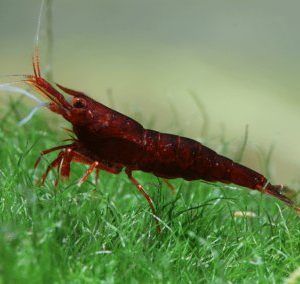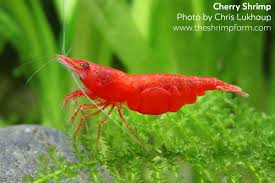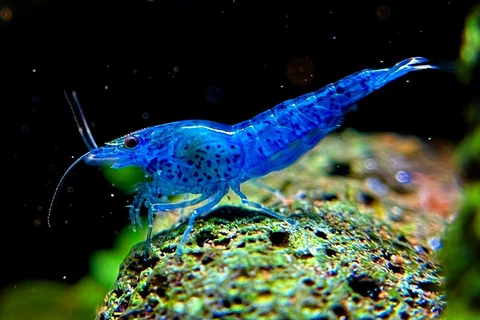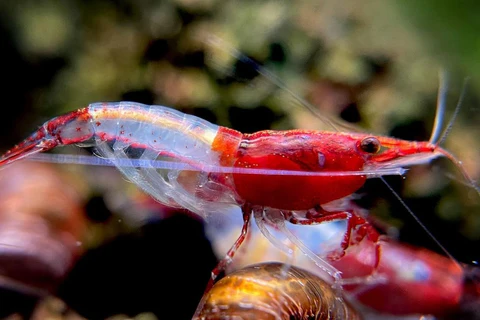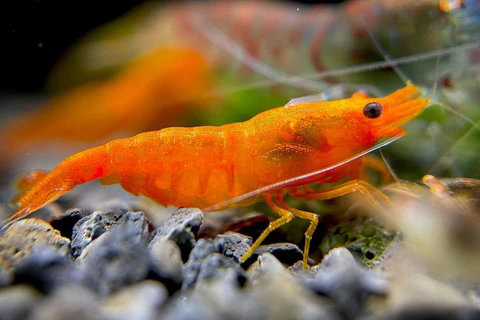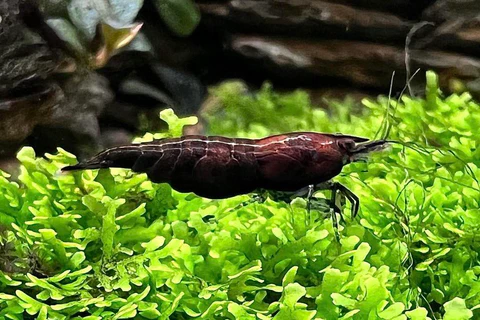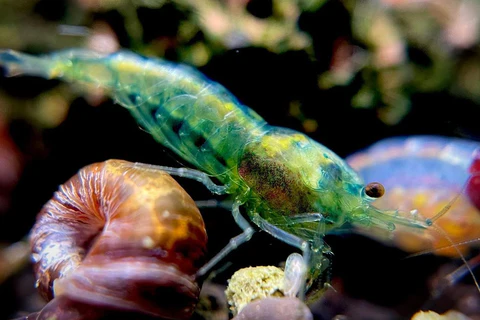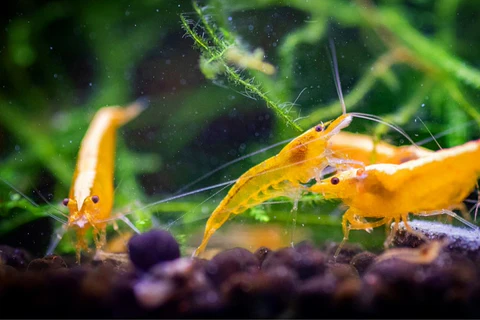
Scientific Classification
Quick Stats
About This Species
Basic Description
The Red Cherry Shrimp is a vibrant and active dwarf shrimp, making it one of the most popular choices for freshwater aquariums, especially for newcomers to the hobby. Its bright coloration adds a splash of life to any tank. Originally from Taiwan, these shrimp are part of a larger family of color variations, so you might also see them sold as Blue Dream, Yellow Sakura, or Snowball Shrimp – but they are all the same resilient species. They are peaceful and industrious, spending their days meticulously cleaning plants, substrate, and decorations. You'll see them constantly picking at surfaces, searching for tiny bits of leftover food, algae, and microscopic organisms called biofilm. This cleaning behavior makes them a fantastic maintenance crew for a planted tank. Because they are social and feel safer in numbers, they should be kept in a small group. A well-planted aquarium with gentle water flow is the perfect home for them, providing plenty of surfaces for them to graze on and places to hide, especially after they shed their skin to grow. Their small size and minimal waste production mean they can thrive in smaller aquariums where fish might not be suitable, making them perfect for desktop nano tanks.
Detailed Description
Neocaridina davidi, commonly known as the Red Cherry Shrimp, is a cornerstone species in the freshwater invertebrate hobby due to its adaptability and prolific breeding. For prospective keepers, establishing a mature aquarium is paramount. These shrimp thrive in a stable environment, feeding primarily on biofilm and algae that develop over time. A 'mature' tank, one that has been running for several weeks or months, ensures a steady food supply and stable water chemistry. While they can adapt to a range of parameters, sudden fluctuations are their greatest threat. Therefore, using a drip-acclimation method when introducing them to a new tank is crucial for their survival. Tank setup should prioritize their needs. A heavily planted environment, especially with fine-leaved plants like mosses (e.g., Java Moss, Christmas Moss) or floating plants with long roots, offers extensive surface area for grazing and provides crucial shelter. This is particularly important during molting, or ecdysis, a process where they shed their exoskeleton to grow. During this vulnerable period, shrimp will hide until their new shell hardens. A lack of hiding spots can lead to stress or predation. The water's General Hardness (GH) is directly linked to successful molting, as they absorb minerals like calcium and magnesium from the water column to build their new exoskeleton. Inconsistent GH can lead to failed molts, which is a common cause of death. While they are excellent cleaners, their diet should be supplemented. High-quality shrimp pellets rich in calcium, blanched vegetables like zucchini or spinach, and occasional protein-based foods will ensure a balanced diet. However, overfeeding is a common mistake. Feed only what they can consume in an hour or two to prevent water quality degradation. Breeding is straightforward, provided the conditions are stable. Females can be identified by their larger size and a curved underbelly. Often, a yellow or green 'saddle' can be seen on their back, which contains undeveloped eggs. After a molt, the female releases pheromones, and fertilization occurs. The eggs are then moved to her swimmerets, and she is referred to as 'berried.' The eggs hatch into miniature, fully-formed shrimplets after about 30 days. These young require no specialized care beyond the biofilm and microturbulence provided in a mature, moss-filled tank. When considering tank mates, extreme caution is necessary. Due to their small size and lack of defenses, almost any fish with a mouth large enough to fit a shrimp will likely eat them, including seemingly peaceful species like Bettas or Gouramis. The best tank mates are other dwarf shrimp, small peaceful snails (like Nerites or Ramshorns), and perhaps Otocinclus catfish. For a thriving, breeding colony, a species-only tank is the ideal setup.
Scientific Description
Neocaridina davidi belongs to the Atyidae family, a group of freshwater shrimp characterized by the tufts of setae on the tips of their chelae (claws), used for filter-feeding microorganisms. Although they possess this capability, N. davidi primarily functions as a benthic grazer, scraping biofilm from surfaces. The species exhibits significant phenotypic plasticity, which selective breeding has exploited to create a vast array of color morphs (e.g., 'Red Cherry', 'Blue Dream', 'Yellow Sakura'). These are all interfertile varieties of the same species and are not subspecies. Cross-breeding different color morphs will typically result in offspring reverting to a wild-type brown or clear coloration over generations, demonstrating regression to the mean. The life cycle of N. davidi is characterized by direct development, a key factor in its successful captive propagation. Unlike many other decapods, it completely bypasses a free-swimming larval stage. Fertilized eggs are incubated while attached to the female's pleopods. Embryonic development is entirely lecithotrophic, with the yolk providing all necessary nutrition. Upon hatching, individuals emerge as fully-formed, benthic post-larvae (shrimplets) that share the same ecological niche as the adults. This reproductive strategy eliminates the need for specialized larval rearing conditions, such as brackish water or planktonic food, contributing to its 'easy' breeding classification. Physiologically, N. davidi is highly dependent on water chemistry for osmoregulation and ecdysis. The exoskeleton, composed of chitin, proteins, and mineral deposits, requires a steady supply of calcium and magnesium carbonates sourced from the water column (measured as General Hardness, or GH). Ecdysis is a hormonally-controlled process where the old cuticle is shed. During the pre-molt phase, the shrimp resorbs minerals from the old exoskeleton and secretes a new, soft cuticle beneath it. Post-molt, the shrimp rapidly absorbs water to expand its new, larger cuticle before it hardens. Instability in water parameters, particularly GH and Total Dissolved Solids (TDS), can disrupt this delicate process, leading to mortality. From an ecological standpoint, their very low bioload (bioload_factor: 0.3) is a result of their efficient metabolism, small adult size, and detritivorous diet. They are primary consumers that play a significant role in nutrient cycling within a closed aquatic system, converting detritus and algae into biomass with minimal nitrogenous waste output. This makes them an ideal candidate for integrated ecosystems like planted aquascapes, where they contribute to system stability rather than detracting from it.
Aquarium Building Information
Minimum Tank Size
10L
Swimming Zone
middle, bottom
Minimum School Size
5+
Special Requirements
Oxygen Consumption
Very Low
Waste Production
Very Low
Feeding Frequency
Daily
Metabolism Rate
Low
Activity Level
Moderate
Food Types
Wafers, Pellets, Vegetables, Algae, Detritus, Flakes
Sexual Dimorphism
Related Images
Generate Printable Card
Create a printable card for this creature to display in your store or aquarium. The card includes a QR code for quick access to more information.
